

|
by Joseph Brennan. Copyright 2002. |
76 StPassenger service: November 1948 - December 1948.Existing abandoned portions: 2 platforms on 4 trackways. Touring: There is no way to see this station. construction and operationThe Fulton Street subway was the Independent System's main line from downtown Brooklyn to southern Queens. Construction was delayed by funding problems in the early 1930's, solved by federal Works Progress Administration funding starting in 1936. That lasted only a few years, as work on the last portions in Brooklyn was then stopped in 1942 shortly after the nation entered World War II. The portion continuing from east of Rockaway Avenue station to Crystal St, not far west of the future Euclid Ave station, was let in 1938, and the next portion in 1940. After the war ended, workers and materials became available for civilian use again. The badly needed short run to a better terminal at East New York (now named Broadway Junction station) was finished in about a year, opening in December 1946. The last portion opened on 28 November 1948, running along Pennsylvania Ave and Pitkin Ave to the 76 St station just over the Queens border. It included access to a new train yard with access from both Euclid Ave and 76 St stations. The line no sooner opened than an unusual controversy erupted. Charges were made that the last portion had not been built and thus should not be operated. The local news media jumped on this, and in an article in the Queens edition of the Daily News for 30 November 1948, an unnamed engineer with the Fochla Brothers Contractors was quoted saying, "All I know is we built to the borough line like we were given plans, and we put up a solid concrete wall there. If they've knocked it out and built more, that's fine with me, but I can tell you I never saw anyone working farther down the street than we were." A tracklayer, also unidentified, claimed his crew had laid track to the end of their section and found another section of tunnel already completed. While the actual operation of trains to 76 St should have been enough to convince anyone the route existed, spooky rumors continued to spread. At the time the station opened, there were no houses at all on any of the four corners at 76 St and Pitkin Ave. A followup story in the News Queens edition on 2 December told the story of an area man who walked through the intersection each day to reach the Fulton St El station at City Line, a few blocks to the northwest: "I was walking home one day and noticed the new subway entrance. I was amazed because there was nothing there that morning. I don't know how human beings could work so fast." Pressed for a statement, Board of Transportation officials first scoffed but then days later admitted sheepishly that they could not produce contracts for construction or equipment of the portion east of Grant Avenue at the borough line. The unions, suspecting a cover-up of non-union work, threatened to take the matter to court. At this point, federal investigators stepped in. Long time local residents recall men with Air Force identification asking questions about the subway and any other unusual events in the area in the past year and a half. As a result of the problems related to its origins and existence, the 76 Street station was closed after less than a month of service, on 20 December 1948. The Board of Transportation covered the embarrassment by quickly preparing new maps and signs showing Euclid Avenue as the terminal, and no more was said. On 6 July 1949, the Board of Transportation officially adopted a plan to extend the Fulton St subway by diverging north out of Pitkin Ave at Conduit Ave and building a ramp up to the outdated Fulton St El located in Liberty Ave. The board's 1950 building projects were announced in a front-page story in the New York Times of 20 November 1949, which says the ramp would extend the subway "from its present terminus". The reasons for the change of route were not made public, but the change clearly avoided routing any trains through the 76 St station. The Times again gave front page coverage on 22 June 1950 to plans for new subway routes, among them the Second Ave Subway, the predecessor to the 63 St tunnel, and the Chrystie St connections. The "plan for Queens" included adding the Long Island Railroad's Rockaway Line to the subway system. Despite this lengthy extension to the Fulton St route, the awkward routing via the Fulton St El was retained without comment. The accompanying map quietly shows the ramp as the existing route, a fait accompli for which contracts were actually not bid until the next year. The tunnel to 76 St was sealed in 1952 and any remaining evidence of its existence at ground level was erased. Today, more than fifty years later, 76 St station is still secure, and the events leading to its closing are barely remembered. Officials at the Transit Authority today deny it ever existed, just as some folks did in 1948. |
|
|
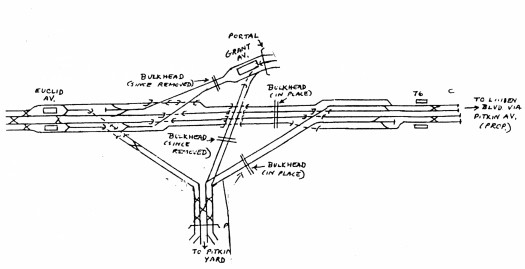
|
Subway historian David Rogoff prepared a track plan of the 76 St station area at an unknown date, but it was probably not published before it appeared in the Bulletin of the New York Division of the Electric Railroaders' Association in July 2001. It shows both the original route to 76 St and the later route to the el via Grant Ave. The Bulletin reports the tunnel sealed in 1952, and says two transit workers recall 76 St as having blue tile. That is the wrong color since Euclid Ave is purple, and Independent Subway local stations have the color of the express station closer to Manhattan. Those who built the 76 St station may have got it wrong. |
|
|
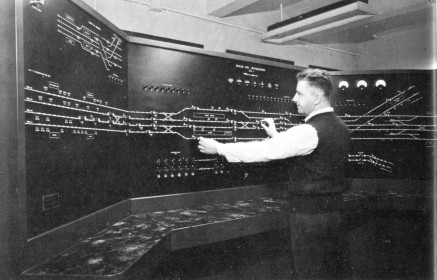
|
For Brian Cudahy's book Under the Sidewalks of New York, the Transit Authority accidentally provided a photograph showing the model board at Euclid Avenue, which includes the track to 76 St station at the extreme right. This was a rare lapse in the wall of silence surrounding the station. Cudahy wisely did not comment on it explicitly, and he was allowed to use the photo again for the revised editions, where it was slightly trimmed at the right edge but still shows the station. The board shows the 1956 route to the el through Grant Ave station angling off to the upper right, and it's interesting that as late as that, the former routing had not been taken off the diagram. New York City Transit Authority, from Brian Cudahy, Under the Sidewalks of New York / the story of the greatest subway system in the world, Brattleboro VT: The Stephen Greene Press, 1979. also in the revised edition, New York: The Stephen Greene Press / Pelham Books, 1988, and the second revised edition, New York: Fordham University Press, 1995. |
|
|
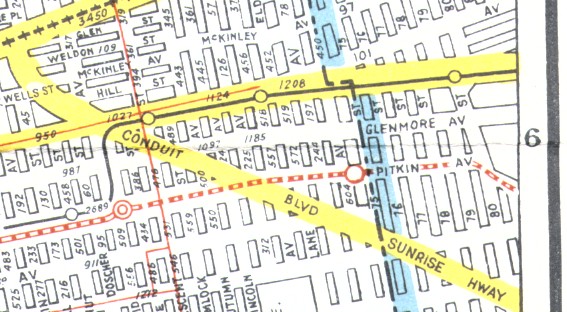
|
On their Brooklyn street map, Hagstrom showed the new subway line running to 76 St and even further along Pitkin Ave to the map border, but used a dashed line to indicate the different status of the portion east of Euclid Ave. The circle for the 76 St station is positioned in midblock on the Brooklyn side of the borough line, either to indicate a Brooklyn entrance on the west side of 75 St, or for clarity. Scan courtesy of Jim Guthrie. |
|
|
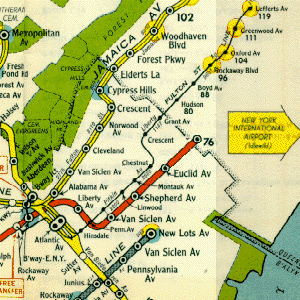
|
The Hagstrom subway map showing the new subway line was replaced only a month later by a revised edition showing the line ending at Euclid Avenue. |
|
|
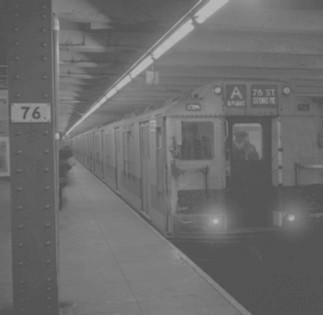
|
The only known photo taken inside 76 St station shows a train of new R 10 cars, delivered only a week before the station opened, with their original destination sign reading 76 ST /OZONE PK. This may have been taken on opening day. These were the first stations in the system to have fluorescent lighting, as shown here. |
|
|
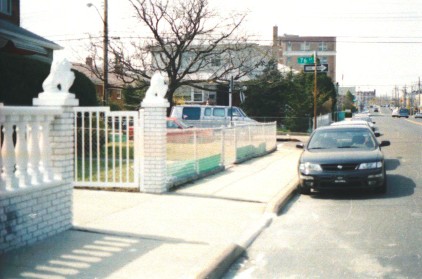
|
A field trip in March 2002 turned up this flat grassy area in front of a house set back from the street. This is probably the location of one of the station stairways. A neighborhood kid told me not to go in there, because it wasn't safe to stand on. He said he bounced a ball in there once and it disappeared right into the ground. A man inside the house came to the door and explained, "Hey you, get out of here. What are you taking pictures?" |
|
|
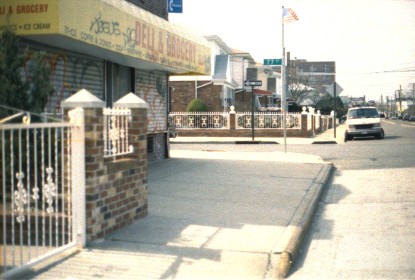
|
On the next block, the only commercial building in the area is this DELI & GROCERY, now closed. Zoning probably permitted it because of the station. The building setback allows for another station stairway, now covered by newer pavement that seemed solid on the day we visited. Page last updated 1 April 2002. |

|
|
|